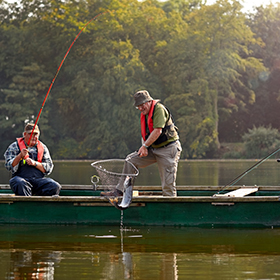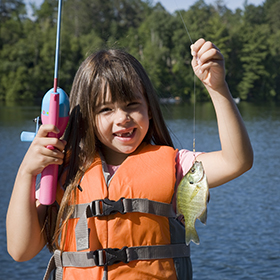Learn more about natural ice fishing baits. Use this information to help you decide which natural baits to use for different fish species this winter.
Have you been looking for ice fishing tips that will help you select the best natural baits? No worries, when it comes to figuring out which worms are going to do the most effective job of enticing your freshwater quarry, we've got you covered. While three of these ice fishing baits are technically considered to be insect larvae as opposed to actual worms (red wigglers are the exception), they each work well when using different ice fishing techniques.
Butterworms
Also known as tebro worms, butterworms are one of the most popular baits that you can use when ice fishing for rainbow trout. However, one of the ice fishing tips you'll have to remember is that butterworms will work best when they are kept dry and alive. To keep them alive, be sure to store them in sawdust. When you are ready to fish, just stick a couple of butterworms on the hook of a spoon, drop it down into your ice fishing hole, and start jigging. Don't forget to pause occasionally so that the fish can take your bait.
Waxworms
Aptly named because they feed on beeswax, waxworms are the larvae of the bee moth and are good natural baits to use when ice fishing for bluegill, crappie or sunfish. When storing waxworms, it's best to use a small container filled with sawdust and keep them in the refrigerator. You can ice fish with waxworms using a number 6 bait holder hook under a float or you can use them to tip small teardrop or tube jigs. The waxworms will become soft and start to fall off of your hook after a few drops, so change your bait often.
Spikes
Spikes are fly larvae or maggots. Due to the very small size of these natural ice fishing baits, they are particularly useful for catching panfish with small mouths, such as crappie or perch. Spikes can be slightly challenging to put on your hook due to their small size, but since they aren't as soft as waxworms or butterworms, they stay put a bit better. If the fish don't seem to be taking larger natural baits, spikes are worth a try. Spikes are another natural ice fishing bait that should be stored in an airtight storage bag or container inside of the refrigerator.
Red Wigglers
When cold weather fishing, just pinch off just an inch or so of a red wiggler when threading it on your hook or jig head. The key is to keep your red wigglers actively wiggling by preventing them from freezing. Red wigglers will work best when you're targeting walleye or trout, but tend to be too much for panfish when fishing through the ice during the winter months.
Realizing that not everyone in the house may be keen on storing natural baits in the family refrigerator, you can always use a mini fridge and store the baits out in the garage instead. Use these ice fishing tips for natural baits to help you catch more fish this winter. Before you head out on the hard water, make sure you have a current fishing license, have read your state's fishing regulations, and know the ice fishing safety guidelines.
Butterworms
Also known as tebro worms, butterworms are one of the most popular baits that you can use when ice fishing for rainbow trout. However, one of the ice fishing tips you'll have to remember is that butterworms will work best when they are kept dry and alive. To keep them alive, be sure to store them in sawdust. When you are ready to fish, just stick a couple of butterworms on the hook of a spoon, drop it down into your ice fishing hole, and start jigging. Don't forget to pause occasionally so that the fish can take your bait.
Waxworms
Aptly named because they feed on beeswax, waxworms are the larvae of the bee moth and are good natural baits to use when ice fishing for bluegill, crappie or sunfish. When storing waxworms, it's best to use a small container filled with sawdust and keep them in the refrigerator. You can ice fish with waxworms using a number 6 bait holder hook under a float or you can use them to tip small teardrop or tube jigs. The waxworms will become soft and start to fall off of your hook after a few drops, so change your bait often.
Spikes
Spikes are fly larvae or maggots. Due to the very small size of these natural ice fishing baits, they are particularly useful for catching panfish with small mouths, such as crappie or perch. Spikes can be slightly challenging to put on your hook due to their small size, but since they aren't as soft as waxworms or butterworms, they stay put a bit better. If the fish don't seem to be taking larger natural baits, spikes are worth a try. Spikes are another natural ice fishing bait that should be stored in an airtight storage bag or container inside of the refrigerator.
Red Wigglers
When cold weather fishing, just pinch off just an inch or so of a red wiggler when threading it on your hook or jig head. The key is to keep your red wigglers actively wiggling by preventing them from freezing. Red wigglers will work best when you're targeting walleye or trout, but tend to be too much for panfish when fishing through the ice during the winter months.
Realizing that not everyone in the house may be keen on storing natural baits in the family refrigerator, you can always use a mini fridge and store the baits out in the garage instead. Use these ice fishing tips for natural baits to help you catch more fish this winter. Before you head out on the hard water, make sure you have a current fishing license, have read your state's fishing regulations, and know the ice fishing safety guidelines.









